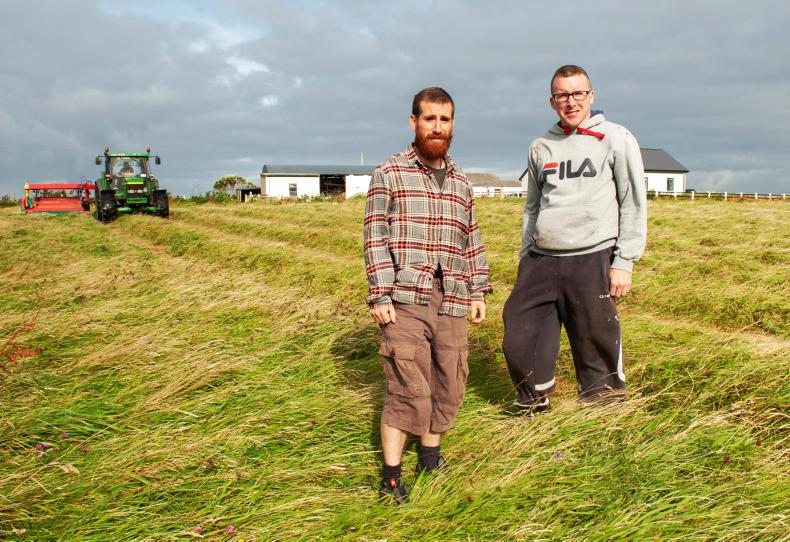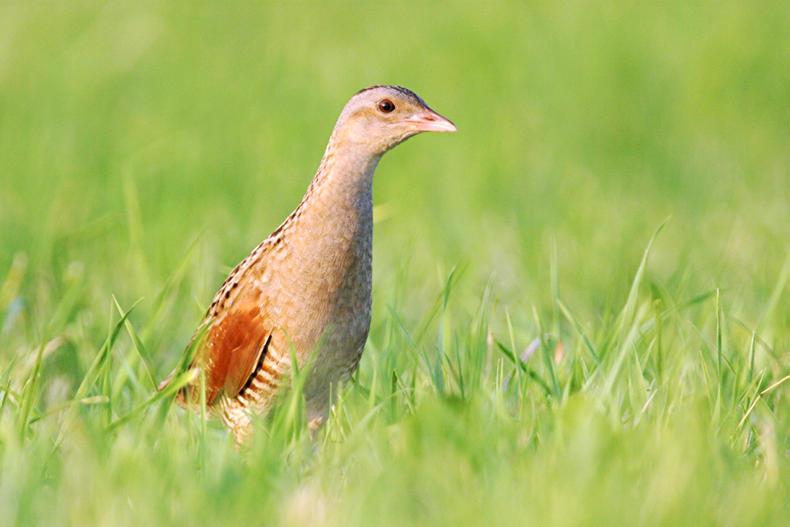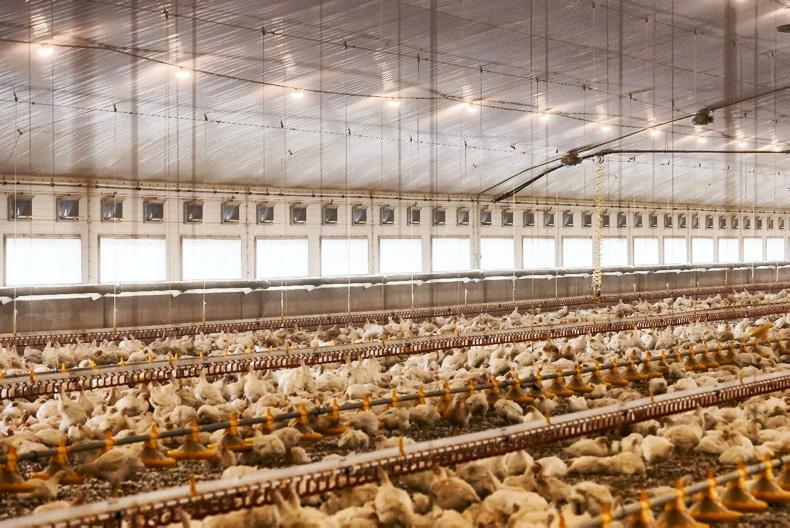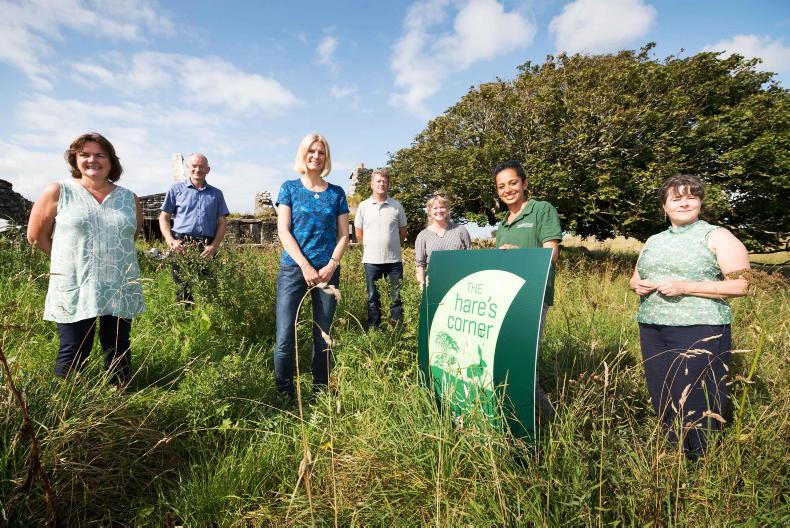The corncrake, or An Traonach as it is known in Irish, is making a comeback in Ireland.
The sound of the summer to many farmers up until the 1980s with its “crex-crex” call, today the bird is in serious decline.
To date this year, 162 calling males have been recorded in the west and northwest, an increase from 151 last year. In 2018, for the first time in four years, the National Parks & Wildlife Service (NPWS) recorded an increase in numbers.
This year, birds have been recorded in four counties and although it is late in the season, numbers are rising steadily; 100 in Donegal, 35 in Mayo, 24 in Galway, two in Sligo and one in Clare.
Liam Loftus is a corncrake field worker with the NPWS, based in west Connacht, and is hopeful for the future of the bird in Ireland, which has been in serious decline for the last 20 years.
He told the Irish Farmers Journal that decline is largely due to changes in farming practices; specifically modernisation and earlier silage cutting.
“The change has been pretty rapid and the birds themselves have been unable to change with it. In the past, they were ubiquitous throughout the country but nowadays the core areas tend to be Mayo, Donegal and Galway, especially the islands in Donegal and Mayo.
“The corncrake really relies on cover throughout the season and in the past there would have been more cover in hay meadows later in the season. Nowadays, fields can be cut with larger machinery quicker and more intensively. They tend to be cut right to the ground where nests are often found,” he said.
Last year was a good year for the bird, with Loftus saying that the weather conditions were very good and that great habitat work was carried out the islands off Donegal.
“Core areas were targeted for the corncrake and community participation was high. The uptake of middle-out mowing by the farmers last year too would have resulted in higher breeding success and we may be seeing the result of that this year,” he said.
Northern Ireland
In July, for the first time in 30 years, it was confirmed that there were two pairs of corncrakes on Rathlin Island, off the coast of Ballycastle, Co Antrim. Rathlin is the only place in Northern Ireland where the birds have been heard in recent years.
Female corncrakes have two clutches each year of eight to 12 eggs. They have a low survival rate, with nests rarely undisturbed as a result of predators such as foxes and cats.
Corncrake farmers
Farmers in the west are availing of two grant schemes to help the corncrake re-establish – the Corncrake Grant Scheme and Corncrake Farm Plan Scheme.
Feargal Ó Cuinngeáin is a vet and has 25ac of land in Belmullet, Co Mayo. He told the Irish Farmers Journal that he has always had a big interest in threatened species, such as the corncrake, twite and lapwings. In 2014, he got involved in the Corncrake Farm Plan Scheme which he said is like a “souped-up” version of GLAS, with better payments and more advice.

Liam Loftus, corncrake field worker with National Parks and Wildlife with Belmullet farmer Leonard Gilbert, who did corncrake-friendly mowing this year. \ Michael McLaughlin
“It [National Parks & Wildlife Service] does up a plan for the farm to manage the corncrakes. One of the main things is lack of early cover. When the corncrake comes back from Africa at the end of April/May, it needs vegetation that is 20cm high. I’ve sown early growing crops that don’t lodge – nettles and hogweed.
“There is a lot of work that goes into keeping a habitat – you can use mushroom compost, well-rotted farm manure and it needs maintenance every year to prevent chickweed, docks, thistles and scutch grass.”
Just under 1ac of Ó Cuinngeáin’s farm is under nettles, some hogweed and iris, which the corncrake finds ideal to settle in for the summer. “The corncrake is a bird of farmland. If there are no farmers, there’s no corncrake.”
He said if farmers were properly supported and incentivised with good technical advice on the corncrake, the bird could survive. “For part-time farmers like myself it is a good source of income. I love doing it.”
Margaret Gaughan, from Emlybeg North, Belmullet, has a small suckler herd and says the secret is to put out fertiliser in mid-April, close off the field and leave it alone. “We don’t walk through it. We cut it for silage later by corncrake-friendly mowing. We had a few corncrakes this year,” she said.
Tom Kelly, a local Teagasc adviser, told the Irish Farmers Journal that he works with farmers in the area to encourage them to farm in a corncrake-friendly fashion, in terms of early cover and late mowing.
“You’d hope there’s a future in it. There are a lot of farmers who would be happy to have it on their land.”
Grant schemes: up to €880/ha available
Under the Corncrake Grant Scheme landowners receive a grant/payment if they agree to delay mowing of meadows, carry out corncrake-friendly mowing when cutting grass and leave an unmown strip of meadow along the side of the field, if required.
If farmers delay mowing until 1 September they can receive €375/ha. At least 49 farmers are taking part in the scheme this year.
Meanwhile, the Corncrake Farm Plan Scheme aims to engage farmers in a five-year plan of early and late cover (ELC) creation, its maintenance and delayed mowing of adjacent meadows. Up to €880/ha is available to farmers under this scheme.
Nine farmers are taking part in the scheme this year, according to the Department of Arts, Heritage and Gaeltacht and €31,362.75 was paid out under the scheme in 2018.
Read more
Corncrakes return to Rathlin Island for first time in 30 years
Corncrake numbers increase after three years of decline
Concern as corncrake population nearly halves in three years
The corncrake, or An Traonach as it is known in Irish, is making a comeback in Ireland.
The sound of the summer to many farmers up until the 1980s with its “crex-crex” call, today the bird is in serious decline.
To date this year, 162 calling males have been recorded in the west and northwest, an increase from 151 last year. In 2018, for the first time in four years, the National Parks & Wildlife Service (NPWS) recorded an increase in numbers.
This year, birds have been recorded in four counties and although it is late in the season, numbers are rising steadily; 100 in Donegal, 35 in Mayo, 24 in Galway, two in Sligo and one in Clare.
Liam Loftus is a corncrake field worker with the NPWS, based in west Connacht, and is hopeful for the future of the bird in Ireland, which has been in serious decline for the last 20 years.
He told the Irish Farmers Journal that decline is largely due to changes in farming practices; specifically modernisation and earlier silage cutting.
“The change has been pretty rapid and the birds themselves have been unable to change with it. In the past, they were ubiquitous throughout the country but nowadays the core areas tend to be Mayo, Donegal and Galway, especially the islands in Donegal and Mayo.
“The corncrake really relies on cover throughout the season and in the past there would have been more cover in hay meadows later in the season. Nowadays, fields can be cut with larger machinery quicker and more intensively. They tend to be cut right to the ground where nests are often found,” he said.
Last year was a good year for the bird, with Loftus saying that the weather conditions were very good and that great habitat work was carried out the islands off Donegal.
“Core areas were targeted for the corncrake and community participation was high. The uptake of middle-out mowing by the farmers last year too would have resulted in higher breeding success and we may be seeing the result of that this year,” he said.
Northern Ireland
In July, for the first time in 30 years, it was confirmed that there were two pairs of corncrakes on Rathlin Island, off the coast of Ballycastle, Co Antrim. Rathlin is the only place in Northern Ireland where the birds have been heard in recent years.
Female corncrakes have two clutches each year of eight to 12 eggs. They have a low survival rate, with nests rarely undisturbed as a result of predators such as foxes and cats.
Corncrake farmers
Farmers in the west are availing of two grant schemes to help the corncrake re-establish – the Corncrake Grant Scheme and Corncrake Farm Plan Scheme.
Feargal Ó Cuinngeáin is a vet and has 25ac of land in Belmullet, Co Mayo. He told the Irish Farmers Journal that he has always had a big interest in threatened species, such as the corncrake, twite and lapwings. In 2014, he got involved in the Corncrake Farm Plan Scheme which he said is like a “souped-up” version of GLAS, with better payments and more advice.

Liam Loftus, corncrake field worker with National Parks and Wildlife with Belmullet farmer Leonard Gilbert, who did corncrake-friendly mowing this year. \ Michael McLaughlin
“It [National Parks & Wildlife Service] does up a plan for the farm to manage the corncrakes. One of the main things is lack of early cover. When the corncrake comes back from Africa at the end of April/May, it needs vegetation that is 20cm high. I’ve sown early growing crops that don’t lodge – nettles and hogweed.
“There is a lot of work that goes into keeping a habitat – you can use mushroom compost, well-rotted farm manure and it needs maintenance every year to prevent chickweed, docks, thistles and scutch grass.”
Just under 1ac of Ó Cuinngeáin’s farm is under nettles, some hogweed and iris, which the corncrake finds ideal to settle in for the summer. “The corncrake is a bird of farmland. If there are no farmers, there’s no corncrake.”
He said if farmers were properly supported and incentivised with good technical advice on the corncrake, the bird could survive. “For part-time farmers like myself it is a good source of income. I love doing it.”
Margaret Gaughan, from Emlybeg North, Belmullet, has a small suckler herd and says the secret is to put out fertiliser in mid-April, close off the field and leave it alone. “We don’t walk through it. We cut it for silage later by corncrake-friendly mowing. We had a few corncrakes this year,” she said.
Tom Kelly, a local Teagasc adviser, told the Irish Farmers Journal that he works with farmers in the area to encourage them to farm in a corncrake-friendly fashion, in terms of early cover and late mowing.
“You’d hope there’s a future in it. There are a lot of farmers who would be happy to have it on their land.”
Grant schemes: up to €880/ha available
Under the Corncrake Grant Scheme landowners receive a grant/payment if they agree to delay mowing of meadows, carry out corncrake-friendly mowing when cutting grass and leave an unmown strip of meadow along the side of the field, if required.
If farmers delay mowing until 1 September they can receive €375/ha. At least 49 farmers are taking part in the scheme this year.
Meanwhile, the Corncrake Farm Plan Scheme aims to engage farmers in a five-year plan of early and late cover (ELC) creation, its maintenance and delayed mowing of adjacent meadows. Up to €880/ha is available to farmers under this scheme.
Nine farmers are taking part in the scheme this year, according to the Department of Arts, Heritage and Gaeltacht and €31,362.75 was paid out under the scheme in 2018.
Read more
Corncrakes return to Rathlin Island for first time in 30 years
Corncrake numbers increase after three years of decline
Concern as corncrake population nearly halves in three years











SHARING OPTIONS